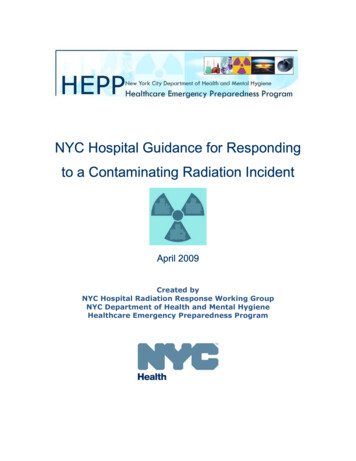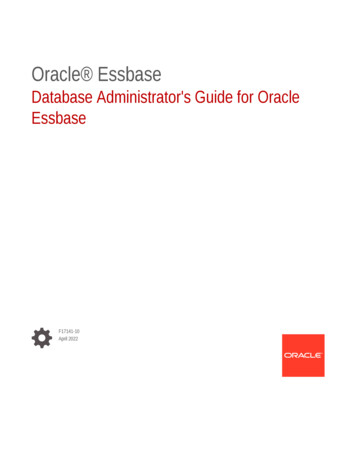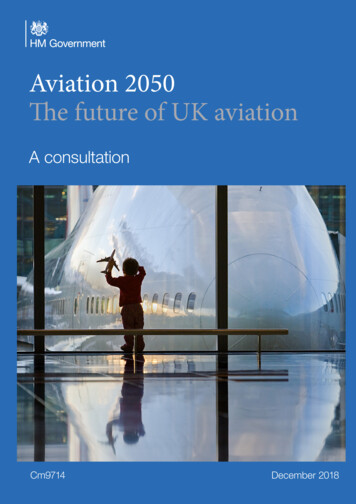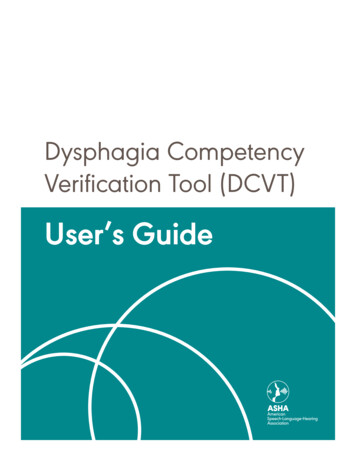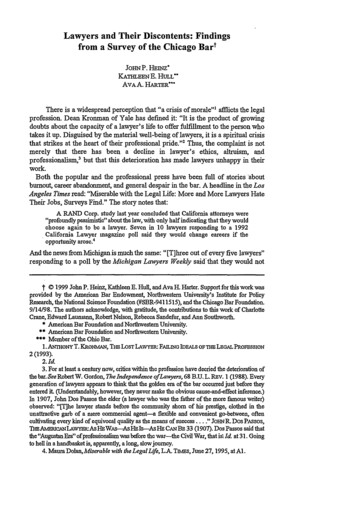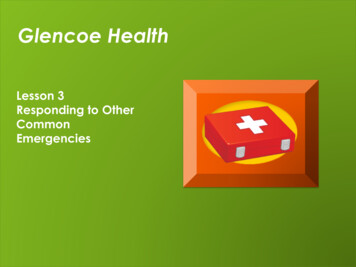
Transcription
UNDERSTANDING AND RESPONDING TO DEPARTMENT OFCHILDREN AND FAMILY SERVICES’ ABUSE AND NEGLECTINVESTIGATIONS IN ILLINOISA Basic Guide for Illinois Parents and Other CaregiversApril 2016The Family Defense Center70 E. Lake St., Suite 1100Chicago, IL 60601Phone: 312-251-9800, Fax: efensecenter.org
TABLE OF CONTENTSPreface i-iiiI. The Basics of DCFS Child Abuse and Neglect InvestigationsA. How DCFS Child Abuse and Neglect Investigations Start: The Hotline, Interplay between Police andDCFS Investigations, Access to Information in Hotline Calls . 1-What is the Hotline?-What information does the Hotline take from people who report abuse or neglect?-Who calls the Hotline and what difference does that make?-Can people who call the Hotline be sued for violating the rights of the person they claim abused orneglected a child?-Am I entitled to know who called the Hotline against me?-What are the possible allegations and how can I find out which allegation is being investigated?B. The First Steps in an Open Investigation: Duties of the “Mandate” Worker in the Division of ChildProtection (DCP); the Initial “Child Endangerment Risk Assessment Protocol” (CERAP) . 4-What happens after a Hotline call is accepted for investigation?-What is a “mandate worker” and what are they expected to do?-What are the typical first steps in the investigation after the mandate worker attempts to see the child?-What decisions does the investigator make when they see the child?C. DCFS Notices in Investigations . 6-What information should I receive if I am being investigated for child abuse or neglect?D. Time Frames and Next Steps in Investigations . .8-What is the time frame for investigations? What can I do if DCFS isn’t taking steps to finish theinvestigation quickly?E. The Rights of the Accused Person or the Parent of the Alleged Victim; Providing Information to DCFSduring the Investigation; the Role of Counsel during an Investigation 9-What are my rights during the investigation?-What sort of evidence should I consider providing to DCFS during an investigation?-Do I have a right to lawyer to help me during a DCFS investigation or an appeal from an indicateddecision?F. The Conclusion of an Investigation and Rights to Appeal Decisions Against You . .12-What decision is made at the conclusion of the investigation?-How will I know the outcome of a DCFS investigation against me?G. Requests for Assessments and for Social Services or Intact Services During Investigations . 14-Under what circumstances might a DCFS investigator ask that I submit to certain service assessments?-What are “intact services” and am I required to participate?
II. What to Expect at a “Typical” DCFS Investigative InterviewA. The Benefits of Having Counsel at an Investigative Interview 17B. What to Expect at the Interview .19-Try to take your own notes; keep notes after the interview if you can.-Try to keep be calm and respectful throughout the interview.C. Chronology of the Interview, Including a List of Questions Asked .21-1. Do you know why DCFS was called or why I am here?-2. Can you give me proof of who you are, your birthdate, and ID?-3. What kind of work do you do?-4. Can you identify who lives with you?-5. Do you take any medication?-6. Do you have any mental health history?-7. Do you have any criminal record?-8. Is there any domestic violence in the home?-9. Do you have any history of substance abuse?-10. How do you discipline your children if they act up?-11. How do you respond to the specific allegations that have been reported to the Hotline?-12. Can you give me two collaterals?-13. Can I speak to your children? I need to see your children and speak to them outside your presence.-Home Safety Checklist.D. Continued Discussion: What To Do About the Problematic Questions (Nos. 5-9 Above)?.29-Do you take any medication?-Do you have any mental health history?-Do you have any criminal record?-Is there any domestic violence in the home?-Do you have a history of substance abuse?-If answering DCFS questions in an investigation is so tricky, why should I interview with DCFS at all?-Can the Family Defense Center help me plan for an investigative interview?E. Questions to Clarify the Status of the Investigation .33-1. Do you have the CANTS 8 notice for this investigation? Can I see it? Can I review it with my clientbefore you ask him questions?-2. Which allegation are you investigating?-3. Can you tell me, basically, what the Hotline call narrative says, since I really don’t know what myclient is accused of doing?
III. If You Work with Children, You May Be Entitled to Special “Dupuy” ProtectionsA. Purpose of the Dupuy “Child Care Worker” Protections . .36B. Description of the Expedited Processes to which Dupuy “Child Care Workers” are Entitled . 37-What procedural protections exist prior to a final decision to “indicate” a finding?-What procedural protections exist once an indicated finding has been entered against a child careworker?C. Who Qualifies for Special Treatment as a “Child Care Worker”?.39-How do I know whether I qualify for the special Dupuy protections?-Who is not a “child care worker” under the Dupuy definitions?-What if I meet the qualifications of a Dupuy “child care worker” but I am being investigated in my homelife and not in my professional capacity?-Is DCFS implementing the Dupuy protections as required?IV. Emergency Removals of Children from their Parents’ CustodyA. Legal Standards for Taking Protective Custody . .42-Under what circumstances will DCFS physically remove my children? What does it mean for DCFS totake protective custody?-How should I respond if a DCFS Investigator is taking protective custody of my children?B. Legal Processes that Follow the Taking of Protective Custody 44-What happens after DCFS takes protective custody?-If a petition is filed in court, how do I prepare for the first court date?V. DCFS Safety Plans, Directives to Leave Your Home or Have Your Children LiveElsewhere, and Restrictions on Contact with Children During InvestigationsA. Overview of Safety Plans . 47-What is a DCFS safety plan?-Why would I “agree” to follow safety plan terms that restrict my contact with my own children?-Under what circumstances will DCFS implement a safety plan?B. Oral Directives Impacting Parents’ Contact with Children .50C. Strategies for Responding to a Safety Plan Demand and/or Oral Directive . .51-What steps can I take in the face of a safety plan or directive even if I don’t have a lawyer?-When is it advisable to consult with a lawyer?-Can a safety plan continue after the investigation has come to an end?-What happens when a safety plan ends?
VI. Special Considerations: Issues arising as to DCFS Interviews of Children and otherDemands Made by DCFS During the InvestigationA. Interviewing Children: General Considerations . 56B. Settings and Timing of Interviews of Your Child .57C. Interviewing Children when Parents Object .58-At home.-In private schools.-In public schools.D. “Victim Sensitive Interviews” at a Children’s Advocacy Center . 61E. Parental Questioning of Children and Allegations of “Coaching” 62F. Medical Treatment and Tests for Injuries that are Under Investigation . .63G. Services and Assessment Demands During Investigations .65-Parenting skills programs or parenting skills classes.-Psychological assessments, sex offender assessments, psychotherapy, or counseling.-Drug or alcohol treatment programs.VII. Steps to Redress Violations of Family Rights in InvestigationsA. Protect Yourself by Pursuing the Administrative Remedies Within the Time Frame to Appeal . .69B. Many Violations of Procedures and Unprofessional Conduct Do Not Give Rise to a “Right to Sue” 70C. The Types of Civil Rights Damages Cases the Family Defense Center Might Consider 70D. Other Available Remedies if Family Members’ Rights in Investigations are Violated 72
APPENDICESBasic Tips for Responding to DCFS Investigations . Appendix ASummary of Concerns about Safety Plans . .Appendix BTemplate: Notification of Dupuy “Child Care Worker” Status . .Appendix CTemplate: Alternative Safety Plan .Appendix DTemplate: Letter Requesting that a Hotline Call be Designated as False/Harassing .Appendix EEXHIBITSList of DCFS Allegations of Harm .Exhibit 1CERAP and Safety Plan Form .Exhibit 2CANTS 8 Notice .Exhibit 3Domestic Violence Assessment Exhibit 4Substance Abuse Assessment Exhibit 5
UNDERSTANDING AND RESPONDING TO DEPARTMENT OFCHILDREN AND FAMILY SERVICES’ ABUSE AND NEGLECTINVESTIGATIONS IN ILLINOISA Basic Guide for Illinois Parents and Other CaregiversPREFACEThe Purpose of this Guide.This guide is meant to provide general information about the child abuse and neglectsystem in Illinois and some guidance for parents and other caregivers when they areinvolved in such investigations. These investigations, which are also called child protectioninvestigations, are conducted by the Illinois Department of Children and Family Services(DCFS).This guide is written with the “wrongly accused” person in mind. The Family DefenseCenter focuses on helping family members navigate the DCFS investigation process andexonerate them from being labeled a child abuser or child neglector when they have notharmed a child. Unfortunately, people who are targets of DCFS investigations often assumethat the system will protect their rights and that justice will be done. At the same time, theymay worry about how best to keep their family intact and avoid being tagged with a terriblelabel of “child abuser” or “child neglector.” Others may simply not know how to respondwhen they learn that DCFS is investigating a claim of abuse or neglect. Still others willwant to use this guide to prepare for answering common questions that often come upduring these investigations.While this guide will not prevent mistakes from being made, we hope that it reduces thenumber of erroneous decisions by helping families and people who work with childrenrespond to investigations.DCFS has a legitimate interest in protecting children from abuse or neglect. But it has nointerest in separating a child from loving and innocent parents, or in labeling an innocentperson as guilty of an offense he or she never committed. Indeed, the Family DefenseCenter believes that the interests of innocent and loving parents and the interests of thechild are the same. We believe in our motto, “To protect children, defend families.”i
Therefore, helping families to defend themselves from a mistaken allegation of abuse orneglect does help children. Children need their families. Parents are generally the bestadvocates for children, but sometimes parents have to defend themselves first, in order tobe able to protect their children.We want to caution our readers, however, about assuming the “worst case scenario” is whatDCFS is likely to do in any specific case. Just because DCFS sometimes removes childrenfrom parents and just because DCFS sometimes makes mistaken findings of abuse orneglect against innocent caregivers does not mean that DCFS always does so, or that DCFSwould do so if you proceeded without regard to the information contained in this guide.Horror stories about DCFS can make parents and caregivers overly worried about whatthey should say to DCFS, and can have a “chilling effect” on parents who have donenothing wrong. After all, in 60-75% of all investigations, DCFS does not find abuse orneglect occurred. While DCFS sometimes reaches incorrect conclusions, that does notmean that good parents should worry about saying exactly the “right” thing. Finding thebalance between saying too much and saying too little can be tricky, as this guide shows,and this guide is thus meant to enlighten parents’ thinking about how to approach a DCFSinvestigation and should not make parents fret over providing the “best” or “right” answers.While we realize this guide may not reach everyone who needs it exactly when they needit most, we hope this guide helps to raise general awareness of the nature of these criticallyimportant investigations. Increased awareness will also help improve the quality of legalrepresentation and advocacy available to individuals who find themselves in the positionof responding to DCFS investigations. Therefore, while this guide is written for parents, itis intended for their lawyers and legal advocates too. In addition, because this guidehighlights some investigative practices that may not be lawful, we hope that futurechallenges to some questionable practices discussed in this guide will advance justice forthe wrongly accused person and further our mission of helping children by defending theirfamilies.Warning (Disclaimer).This guide is not intended to provide specific legal advice. Only a lawyer can give youlegal advice that fits your specific case. Nor is it intended to provide information abouthow to respond to an investigation in another state: each state’s system, laws, policies, andpractices are different. If, after reading this guide, you believe you need legal services tohelp you respond to a pending investigation and you reside within the direct service areafor the Family Defense Center (Cook and collar counties), you may wish to proceed withii
an application for services from the Family Defense Center, or seek other legal counsel.This guide is not a substitute for the direct legal representation a lawyer can potentiallyprovide. The authors of this guide and the Family Defense Center expressly disclaimliability arising from the use of information contained herein. No attorney/clientrelationship is created as a result of this guide’s posting and distribution.Introduction to this Guide.Whether you are facing a child abuse or neglect investigation pending in the IllinoisDepartment of Children and Family Services (“DCFS”), you are trying to help someonewho is in the middle of such an investigation, or you are simply trying to understand howchild abuse or neglect investigations operate in Illinois, this guide may be a useful startingpoint.This guide is organized as follows: Section I discusses the basics of DCFS childprotection investigations, including answering many questions that come up about the stepsin these investigations. Section II walks through one specific investigation and discussesthe specific questions that were asked by an investigator and the steps she took to interviewother family members. This Section contains a long discussion of the appropriateness ofsome of the questions and discusses approaches to answering them. Section III discussesthe particular rights that persons who work with children have during a DCFSinvestigation. Section IV addresses the process when DCFS removes children from theirparents under its power to take protective custody. Section V addresses safety plans anddirectives affecting the care and custody of children during investigations. Section VIdiscusses specific issues that come up in investigations, including interviews of children,medical testing requests, and requests for assessments and services. Section VII discussesremedies when investigations have violated family members’ rights or otherwise beenhandled in an unprofessional manner. At Appendix A to this guide, you will find “BasicTips for Responding to DCFS Investigations,” which consolidates the recommendations ofthis guide into a quick reference tool. Appendix B, “Summary of Concerns about SafetyPlans,” outlines the most problematic features of DCFS “safety plans”; these issues arebeing actively discussed with DCFS and this section will be updated as we seeimprovements in policies and practices. Appendices C-E provide template documentsthat you may wish to use if they are applicable to your situation. Finally, we have alsoattached a collection of Exhibits comprised of common DCFS documents and noticesapplicable to the investigative process.iii
I. The Basics of DCFS Child Abuse and Neglect InvestigationsChild abuse and neglect investigations are complex. There are a host of variables in howchild protection investigations proceed based on individual facts and circumstances,though some common practices are described in this section of the guide.A. How DCFS Child Abuse and Neglect Investigations Start: The Hotline, Interplaybetween Police and DCFS Investigations, Access to Information in Hotline CallsChild abuse and neglect investigations all start in the same way: with a call to the childabuse and neglect Hotline (1-800-CHA-BUSE). Sometimes, a call will have been madefirst to the police and then referred by police to DCFS. Sometimes, DCFS also refers callsto the police when it receives Hotline calls that allege serious physical and sexual abusethat could lead to criminal charges being filed. DCFS and the police should coordinatetheir investigations, and sometimes both police and DCFS officials will be present at thesame interviews. Police investigations focus on determining whether there is a basis forcharging an individual with a crime and punishing them for a criminal act, while the childprotection investigations discussed in this guide focus on whether the child needsprotection and whether the person named in the Hotline call should be labeled responsiblefor abuse or neglect and possibly be restricted in his or her interaction with children. (SeeWorking with the Courts in Child Protection, U.S. DEP’T OF HEALTH AND HUMAN SERV.,OFFICE OF CHILD ABUSE AND NEGLECT (2006), http://www.childwelfare.gov/pubPDFs/courts.pdf, for more discussion of the relationship between criminal/policeinvestigations and child protection/DCFS investigations).If police have contacted you and there is a possibility of criminal charges, you should speakto a criminal defense lawyer. This guide does not address police practice, criminalinvestigations, or the rights of an accused person in a criminal case.What is the Hotline? The child abuse Hotline, which is officially called the State CentralRegister, is actually a call center located in Springfield, Illinois. A state DCFS employeewill answer the call and make a computerized register of the call. Its computer system iscalled “CANTS” (for Child Abuse and Neglect Tracking System), so a CANTS report anda Hotline call actually mean the same thing. When you see an “SCR” number on noticesyou get about your case, that is the specific number assigned to the Hotline call that is thensubsequently investigated.1
Sometimes the call center receives requests for child welfare services or referrals, but thisguide does not discuss this type of call.What information does the Hotline take from people who report abuse or neglect? TheHotline operator who answers a call regarding suspected abuse or neglect of a child willhave to decide if the call alleges some form of harm, or risk of harm, to a child under theage of 18. The harm must be something that fits within the enumerated categories ofallegations that are defined by Illinois rules and procedures. The Hotline operatorcompletes a form and documents in a narrative the factual information the caller hasprovided, and then codes the investigation into the specific allegation category that is mostapplicable to the factual claims the caller has made. (The rules and procedures setting outthe categories of the DCFS “Allegations of Harm” and their corresponding numbers areavailable online at http://www.illinois.gov/dcfs/aboutus/notices/ Pages/default.aspx).Not every call made to the Hotline gets accepted for investigation. If, for example, theperson called the Hotline alleging that you had refused to buy your child the princesscostume she wants, that is not child abuse or neglect; that call would be rejected by theHotline. But deliberately burning your child’s hand, causing second degree burns, is childabuse and a report of that call would almost certainly be accepted for investigation if therewas enough information to identify the child and the accused person. The Hotline operatorshould get enough information from the caller to decide whether there is a possible case ofabuse or neglect assuming the caller’s claims are true. The Hotline operator will also askfor the child’s name, birth date, residence, name(s) of the suspected perpetrator(s), namesof the parents (if different from the suspected perpetrator), and the names and birth datesof any other children living in the home.After completing the record of the call in a case that is accepted for investigation, theHotline call record will be sent to a DCFS office in the county where the child resides tostart an investigation.Who calls the Hotline and what difference does that make? Anyone can call the Hotlineand make a report of child abuse or neglect, and thousands of people do that every year.The callers include neighbors, ex-spouses, landlords, teachers, doctors, and even childrenthemselves. The callers do not necessarily have to give their names; the Hotline will acceptanonymous reports.2
Most people who work with children are considered mandated child abuse reporters, whichmeans they have a legal duty under the Illinois Abused and Neglected Child Reporting Actto call the Hotline when they have a reasonable basis to believe that a child with whomthey are working is an abused or neglected child. A list of all mandated reporters byprofession can be found at: ges/index.aspx. DCFS is more likely to make findings of abuse or neglect if theinvestigation starts with a call to the Hotline by a professional mandated reporter. But manymandated reporter calls are also not found to be actual abuse or neglect after investigation.Sometimes mandated reporters call because they believe they have to do so and not becausethey actually believe there was abuse or neglect.Can people who call the Hotline be sued for violating the rights of the person they claimabused or neglected a child? People who call the Hotline have “good faith” immunityfrom suit—meaning that the only grounds for suing them is if the target of the Hotline callcan show “bad faith” (e.g., malice, a personal and improper agenda) motivated the call andthat there was no reasonable suspicion to support the call. It is very hard to show that a callwas motivated by bad faith. It is not impossible, but the person suing the Hotline caller hasto show much more than that the call was not correct. See Section VII of this Manual (Stepsto Redress Violations of Family Rights in Investigations).Am I entitled to know who called the Hotline against me? No. While you already mayknow the reporter’s identity, the identity of the Hotline caller is protected by a strictconfidentiality law. That means that even if you suspect you know who the Hotline calleris, you generally ARE NOT entitled to be told the identity of the person who called in theHotline report. Even if you know who called the Hotline, DCFS is likely to strenuouslyobject to giving out any information about the Hotline caller and is likely to refuse to eitherconfirm or refute your suspicions as to the caller’s identity. (There are a few exceptionsbut these exceptions are so rare and arise only in litigation, so this guide does not discussthem.).What are the possible allegations and how can I find out which allegation is beinginvestigated? DCFS’s “Allegations of Harm” system divides all types of abuse and neglectinto categories and gives each category a name and a number. Some allegations arecategorized as only abuse (e.g., “#21 Sexual Molestation”) or only neglect (e.g., “#74Inadequate Supervision”) while others either abuse or neglect (e.g., “#9 Bone Fractures byAbuse / #59 Bone Fractures by Neglect”). Allegation numbers below 30 are the “abuse”categories, while numbers over 30 are the “neglect” categories. So if you are accused of3
only allegation 79, for example, you would know that that’s a neglect allegation and not anabuse allegation. You can find a full listing of the enumerated categories at Exhibit 1 ofthis guide.The allegations are all set out in the DCFS Rules and Procedures, at Rule and Procedures300, Appendix B. See 08900300ZZ9996bR.html (Rule 300, Appendix B, containing the definition of each s/notices/Documents/Procedures 300 Appendix B.pdf (Procedures 300, Appendix B, containing the specific procedure required forinvestigating each allegation). If you know generally what the accusation is, or you havealready received a notice concerning the investigation, you can look up the allegationwithin DCFS Rules and Procedures 300, Appendix B, to see how DCFS defines this typeof abuse or neglect.B. The First Steps in an Open Investigation: Duties of the “Mandate” Worker in theDivision of Child Protection (DCP); the Initial “Child Endangerment RiskAssessment Protocol” (CERAP)What happens after a Hotline call is accepted for investigation? The Hotline will referthe call to a local DCFS field office for assignment to a “mandate worker” and then to aprimary investigator for a fuller investigation. More than one investigator may be assignedto an investigation if the child resides in a different field office region than the personaccused of abusing the child. Investigations with more than one assigned DCFS office arereferred to as “parallel” investigations and the investigators assigned to investigation areasother than where the child lives are called “parallel workers.”What is a “mandate worker” and what are they expected to do? The “mandate worker”is expected to make a “good faith” attempt to see the child. Such an attempt is required tobe made within 24 hours of the Hotline call. A “good faith attempt” need not result in asuccessful contact with the child as long as an effort is made. When a mandate workermakes an attempt to contact the child, the parent or caretaker does not have to permit themandate worker to talk to the child or come into the home. The one exception is thatfacilities licensed by DCFS must allow mandate workers and other investigators into thefacility or they may face consequences for their licenses. See DCFS Procedures 383,Licensing Enforcement (July 2010), ents/procedures 383.pdf. Mandate workers and other DCFS investigators havespecial emergency powers, however, as discussed in Sections IV and V below, and4
depending on what they discover when they come out to see the child, there may be otheractions they are expected to take.What are the typical first steps in the investigation after the mandate worker attempts tosee the child? The assigned primary investigator (this could be the mandate worker or itcould be new person who is expected to take over the investigation) will want to see thechild, interview the child, talk to the parents and other witnesses as long as those peopleagree to be interviewed, and examine the place where the abuse or neglect occurred. DCFSinvestigators are expected to make written records of all of their contacts in investigations.These notes are supposed to be electronically entered into the investigation file within 48hours, though the Family Defense Center rarely sees files that consistently meet thatstandard.Each investigator has a supervisor who is responsible for developing a plan for theinvestigation. Most initial investigation plans the Family Defense Center sees are standardtemplates that include the following directions to the investigator: see the child, completea domestic violence screen and a substance abuse screen, run a CANTS (“child abuse andneglect tracking system”) check and LEADS (“law enforcement automated data system”)check (i.e., check the State Central Register and do a criminal background check), conducta scene investigation, consult Procedures 300 for the relevant allegation, contact the PCP(primary care physician), contact teachers, etc. Usually these instructions are quite genericand oftentimes even these steps laid out in an early supervision note are not necessarilycompleted fully.What decisions does the investigator make when they see the child? The Investigator isrequired to conduct a “CERAP” (Child Endangerment Risk Assessment Protocol”). Thisis a list of potential “safety threats” and if the investigator checks any box indicating thepresence of a potential safety threat, the CERAP is marked “unsafe” and the investigatorand the supervisor must decide whether further actions are necessary, such as takingprotective custody or implementing a “safety plan.” DCFS policy currently provides thatthe mere presence of certain allegations automatically results in an “unsafe” CERAPdetermination and requires either a safety plan or removal of the child from the parents.(The Family Defense Center believes that this policy as written is illegal but DCFScontinues to follow a policy of automatically requiring safety plans or removals in somecases. The Family Defense Center is pressing DCFS to change this policy and practice.)See Section IV on the legal standard for taking protective custody of children from their5
parents and Section V on Safety Plans. See also Exhibit 2 to this guide (CERAP and SafetyPlan forms).DCFS investigators (that is, investigators who work in t
UNDERSTANDING AND RESPONDING TO DEPARTMENT OF CHILDREN AND FAMILY SERVICES' ABUSE AND NEGLECT INVESTIGATIONS IN ILLINOIS A Basic Guide for Illinois Parents and Other Caregivers
